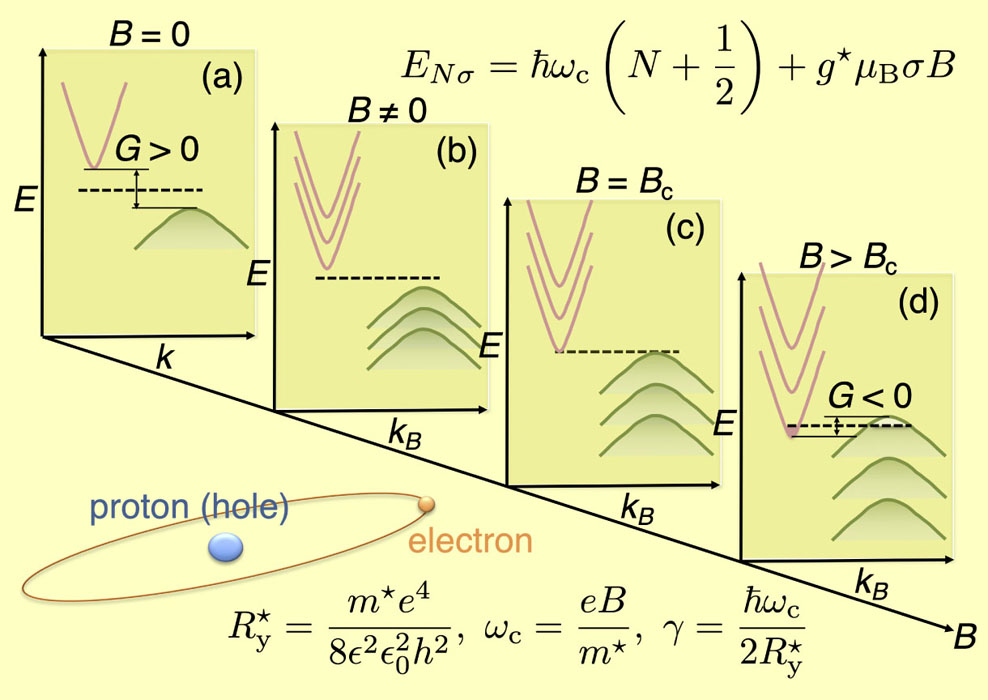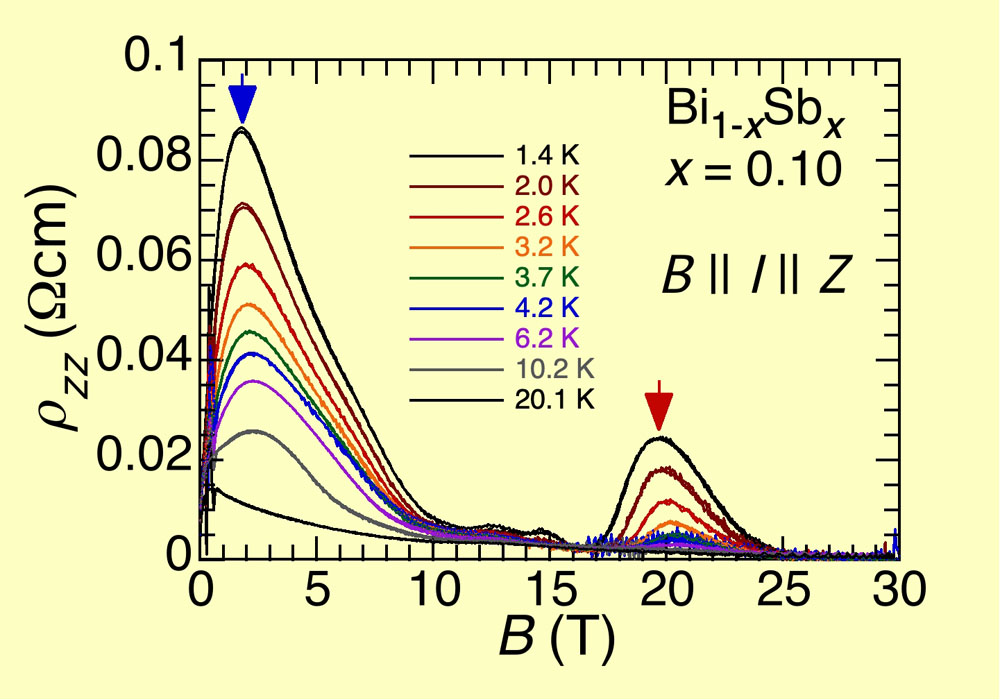Field-Induced Insulating State in a Topological Insulator BiSb Alloy
Tokunaga Group
Applying high-enough magnetic fields on metals realizes the quantum limit states, in which all the carriers are accommodated in the lowest Landau level. Since the carriers are confined in the smallest cyclotron orbit, the kinetic degree of freedom normal to the field is suppressed in this state. Thus, the ratio between Coulomb interaction and bandwidth, a measure of electron correlation, grows as the field increases. Such strong correlation in the quantum limit state can realize anomalous quantum state, like the fractional quantum Hall effect in two-dimensional electron systems. On the other hand, it is an open question what kind of quantum states can be realized by the effect of a strong correlation in the quantum limit state of a three-dimensional system [1]. In particular, quantum limit states of semimetals in which electrons and holes coexist are ideal platforms for realizing novel quantum states.
In this context, we focused on narrow gap semiconductors in which the gap can be closed by external magnetic fields, as illustrated in Fig. 1. Continuous valence and conduction bands at a zero magnetic field split into discrete Landau sub-bands in finite magnetic fields. These Landau sub-bands can be continuously shifted by a magnetic field with the Zeeman and cyclotron energies. We can close the gap in some materials at a specific field, causing semiconductor-semimetal transition at a critical field of Bc. The realized semimetallic state is a spin-polarized quantum limit state. We can expect the emergence of a novel quantum state above Bc.
As a target, we focus on a BiSb alloy. The BiSb alloys have attracted renewed interest after recognized as the first example of topological insulators [2]. Applying a magnetic field to this system can close the gap due to the level crossing of spin-split Landau levels in the conduction and valence bands. We found that further magnetic field application realizes an insulating state in this realized field-induced semimetallic state.

Fig. 1. Schematic of field-induced semiconductor-semimetal transition. Application of magnetic field changes continuous dispersion at a zero magnetic field (a) to discrete Landau sub-bands (b). In some materials, we can close the gap at a critical field of Bc (c) and realize a spin-polarized quantum limit state in a semimetallic phase (d). As illustrated in the inset, the electron-hole system in semimetals can reproduce an electron-proton system in an extremely high magnetic field.
Figure 2 shows longitudinal magnetoresistance in a single crystal of Bi1-xSbx (x = 0.10) at various temperatures [3]. Here, magnetic fields and electric currents are applied along the three-fold rotational axis of the crystal. In this field direction, Zeeman energy in the valence band is significantly larger than the cyclotron energy, so the application of the field higher than 11 T causes a semiconductor-semimetal transition at this field. Our results of magnetoresistance show metallic behavior above 11 T while causing insulating again at around 20 T and temperatures below 4 K.
This field-induced semimetallic state is a spin-polarized quantum limit state, in which we expect a strong correlation effect. The correlation effect in such an electron-hole system has been expected to host the BEC or BCS state of excitons (excitonic phase) at the vicinity of the zero-gap state. Estimation from our experimental results revealed that the binding energy between an electron and a hole becomes 0.3 meV, which is comparable to the thermal energy of 4 K. In addition, interparticle distance becomes also comparable with the thermal de Broglie length below 3 K. These estimations suggest possible emergence of the excitonic phase in BiSb.
The electron-hole systems of semimetals in magnetic fields can reproduce the electron-proton system under extremely high magnetic fields [4]. Suppose the effect of a magnetic field is measured by the ratio of cyclotron energy to Rydberg energy. In that case, the magnetic field effect is amplified in semimetals with small effective mass and large relative permittivity. Applying a magnetic field of 20 T to this BiSb alloy results in this ratio γ of ~ 4000, corresponding to a situation in which a magnetic field of one billion Tesla is applied to hydrogen atoms. What happens when the number of positive and negative carriers is continuously increased from zero under such conditions? Our results in a semimetal may reproduce the quantum state exhibited by hydrogen atoms in a billion Tesla magnetic field.
References
- [1] B. I. Halperin, Jpn. J. Appl. Phys. 26, 1913 (1987).
- [2] D. Hsieh et al., nature 452, 970 (2008).
- [3] Y. Kinoshita et al., Phys. Rev. B 107, 125140 (2023).
- [4] Y. Kuramoto, Hankinzokuchu no Densi-Seikou Soukan to Chouonpa no Kyodai Ryousigensui (in Japanese) (Kyoritsu 1982).

